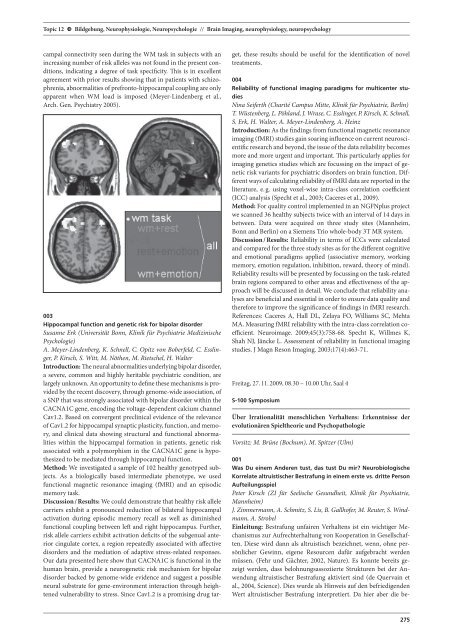Psychische Erkrankungen in der Lebensspanne ... - DGPPN
Psychische Erkrankungen in der Lebensspanne ... - DGPPN
Psychische Erkrankungen in der Lebensspanne ... - DGPPN
Erfolgreiche ePaper selbst erstellen
Machen Sie aus Ihren PDF Publikationen ein blätterbares Flipbook mit unserer einzigartigen Google optimierten e-Paper Software.
Topic 12 G Bildgebung, Neurophysiologie, Neuropsychologie // Bra<strong>in</strong> Imag<strong>in</strong>g, neurophysiology, neuropsychology<br />
campal connectivity seen dur<strong>in</strong>g the WM task <strong>in</strong> subjects with an<br />
<strong>in</strong>creas<strong>in</strong>g number of risk alleles was not found <strong>in</strong> the present conditions,<br />
<strong>in</strong>dicat<strong>in</strong>g a degree of task specificity. This is <strong>in</strong> excellent<br />
agreement with prior results show<strong>in</strong>g that <strong>in</strong> patients with schizophrenia,<br />
abnormalities of prefronto-hippocampal coupl<strong>in</strong>g are only<br />
apparent when WM load is imposed (Meyer-L<strong>in</strong>denberg et al.,<br />
Arch. Gen. Psychiatry 2005).<br />
003<br />
Hippocampal function and genetic risk for bipolar disor<strong>der</strong><br />
Susanne Erk (Universität Bonn, Kl<strong>in</strong>ik für Psychiatrie Mediz<strong>in</strong>ische<br />
Psychologie)<br />
A. Meyer-L<strong>in</strong>denberg, K. Schnell, C. Opitz von Boberfeld, C. Essl<strong>in</strong>ger,<br />
P. Kirsch, S. Witt, M. Nöthen, M. Rietschel, H. Walter<br />
Introduction: The neural abnormalities un<strong>der</strong>ly<strong>in</strong>g bipolar disor<strong>der</strong>,<br />
a severe, common and highly heritable psychiatric condition, are<br />
largely unknown. An opportunity to def<strong>in</strong>e these mechanisms is provided<br />
by the recent discovery, through genome-wide association, of<br />
a SNP that was strongly associated with bipolar disor<strong>der</strong> with<strong>in</strong> the<br />
CACNA1C gene, encod<strong>in</strong>g the voltage-dependent calcium channel<br />
Cav1.2. Based on convergent precl<strong>in</strong>ical evidence of the relevance<br />
of Cav1.2 for hippocampal synaptic plasticity, function, and memory,<br />
and cl<strong>in</strong>ical data show<strong>in</strong>g structural and functional abnormalities<br />
with<strong>in</strong> the hippocampal formation <strong>in</strong> patients, genetic risk<br />
associated with a polymorphism <strong>in</strong> the CACNA1C gene is hypothesized<br />
to be mediated through hippocampal function.<br />
Method: We <strong>in</strong>vestigated a sample of 102 healthy genotyped subjects.<br />
As a biologically based <strong>in</strong>termediate phenotype, we used<br />
functional magnetic resonance imag<strong>in</strong>g (fMRI) and an episodic<br />
memory task.<br />
Discussion / Results: We could demonstrate that healthy risk allele<br />
carriers exhibit a pronounced reduction of bilateral hippocampal<br />
activation dur<strong>in</strong>g episodic memory recall as well as dim<strong>in</strong>ished<br />
functional coupl<strong>in</strong>g between left and right hippocampus. Further,<br />
risk allele carriers exhibit activation deficits of the subgenual anterior<br />
c<strong>in</strong>gulate cortex, a region repeatedly associated with affective<br />
disor<strong>der</strong>s and the mediation of adaptive stress-related responses.<br />
Our data presented here show that CACNA1C is functional <strong>in</strong> the<br />
human bra<strong>in</strong>, provide a neurogenetic risk mechanism for bipolar<br />
disor<strong>der</strong> backed by genome-wide evidence and suggest a possible<br />
neural substrate for gene-environment <strong>in</strong>teraction through heightened<br />
vulnerability to stress. S<strong>in</strong>ce Cav1.2 is a promis<strong>in</strong>g drug tar-<br />
get, these results should be useful for the identification of novel<br />
treatments.<br />
004<br />
Reliability of functional imag<strong>in</strong>g paradigms for multicenter studies<br />
N<strong>in</strong>a Seiferth (Charité Campus Mitte, Kl<strong>in</strong>ik für Psychiatrie, Berl<strong>in</strong>)<br />
T. Wüstenberg, L. Pöhland, J. Wrase, C. Essl<strong>in</strong>ger, P. Kirsch, K. Schnell,<br />
S. Erk, H. Walter, A. Meyer-L<strong>in</strong>denberg, A. He<strong>in</strong>z<br />
Introduction: As the f<strong>in</strong>d<strong>in</strong>gs from functional magnetic resonance<br />
imag<strong>in</strong>g (fMRI) studies ga<strong>in</strong> soar<strong>in</strong>g <strong>in</strong>fluence on current neuroscientific<br />
research and beyond, the issue of the data reliability becomes<br />
more and more urgent and important. This particularly applies for<br />
imag<strong>in</strong>g genetics studies which are focuss<strong>in</strong>g on the impact of genetic<br />
risk variants for psychiatric disor<strong>der</strong>s on bra<strong>in</strong> function. Different<br />
ways of calculat<strong>in</strong>g reliability of fMRI data are reported <strong>in</strong> the<br />
literature, e. g. us<strong>in</strong>g voxel-wise <strong>in</strong>tra-class correlation coefficient<br />
(ICC) analysis (Specht et al., 2003; Caceres et al., 2009).<br />
Method: For quality control implemented <strong>in</strong> an NGFNplus project<br />
we scanned 36 healthy subjects twice with an <strong>in</strong>terval of 14 days <strong>in</strong><br />
between. Data were acquired on three study sites (Mannheim,<br />
Bonn and Berl<strong>in</strong>) on a Siemens Trio whole-body 3T MR system.<br />
Discussion / Results: Reliability <strong>in</strong> terms of ICCs were calcu lated<br />
and compared for the three study sites as for the different cog nitive<br />
and emotional paradigms applied (associative memory, work <strong>in</strong>g<br />
memory, emotion regulation, <strong>in</strong>hibition, reward, theory of m<strong>in</strong>d).<br />
Reliability results will be presented by focuss<strong>in</strong>g on the task-related<br />
bra<strong>in</strong> regions compared to other areas and effectiveness of the approach<br />
will be discussed <strong>in</strong> detail. We conclude that reliability analyses<br />
are beneficial and essential <strong>in</strong> or<strong>der</strong> to ensure data quality and<br />
therefore to improve the significance of f<strong>in</strong>d<strong>in</strong>gs <strong>in</strong> fMRI research.<br />
References: Caceres A, Hall DL, Zelaya FO, Williams SC, Mehta<br />
MA. Measur<strong>in</strong>g fMRI reliability with the <strong>in</strong>tra-class correlation coefficient.<br />
Neuroimage. 2009;45(3):758-68. Specht K, Willmes K,<br />
Shah NJ, Jäncke L. Assessment of reliability <strong>in</strong> functional imag <strong>in</strong>g<br />
studies. J Magn Reson Imag<strong>in</strong>g. 2003;17(4):463-71.<br />
Freitag, 27. 11. 2009, 08.30 – 10.00 Uhr, Saal 4<br />
S-100 Symposium<br />
Über Irrationalität menschlichen Verhaltens: Erkenntnisse <strong>der</strong><br />
evolutionären Spieltheorie und Psychopathologie<br />
Vorsitz: M. Brüne (Bochum), M. Spitzer (Ulm)<br />
001<br />
Was Du e<strong>in</strong>em An<strong>der</strong>en tust, das tust Du mir? Neurobiologische<br />
Korrelate altruistischer Bestrafung <strong>in</strong> e<strong>in</strong>em erste vs. dritte Person<br />
Aufteilungsspiel<br />
Peter Kirsch (ZI für Seelische Gesundheit, Kl<strong>in</strong>ik für Psychiatrie,<br />
Mannheim)<br />
J. Zimmermann, A. Schmitz, S. Lis, B. Gallhofer, M. Reuter, S. W<strong>in</strong>dmann,<br />
A. Strobel<br />
E<strong>in</strong>leitung: Bestrafung unfairen Verhaltens ist e<strong>in</strong> wichtiger Mechanismus<br />
zur Aufrechterhaltung von Kooperation <strong>in</strong> Gesellschaften.<br />
Diese wird dann als altruistisch bezeichnet, wenn, ohne persönlicher<br />
Gew<strong>in</strong>n, eigene Resourcen dafür aufgebracht werden<br />
müssen. (Fehr und Gächter, 2002, Nature). Es konnte bereits gezeigt<br />
werden, dass belohnungsassoziierte Strukturen bei <strong>der</strong> Anwendung<br />
altruistischer Bestrafung aktiviert s<strong>in</strong>d (de Querva<strong>in</strong> et<br />
al., 2004, Science). Dies wurde als H<strong>in</strong>weis auf den befriedigenden<br />
Wert altruistischer Bestrafung <strong>in</strong>terpretiert. Da hier aber die be-<br />
275


